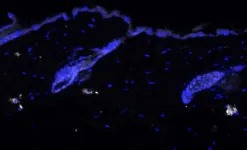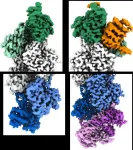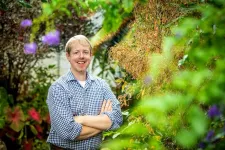(Press-News.org) A team of researchers from IRB Barcelona and CNAG identifies the IL-17 protein as a determining factor in skin ageing.
Blocking the function of IL-17 reduces the pro-inflammatory state and delays the appearance of age-related features in the skin.
Published in the journal Nature Aging, the work opens up new perspectives in the development of therapies to improve skin ageing health.
A team of scientists from the Institute for Research in Biomedicine (IRB Barcelona) in collaboration with the National Center for Genomic Analysis (CNAG) has discovered that IL-17 protein plays a central role in skin ageing. The study, which was led by Dr. Guiomar Solanas, Dr. Salvador Aznar Benitah, both at IRB Barcelona, and Dr. Holger Heyn, at CNAG, highlights an IL-17-mediated ageing process to an inflammatory state.
Skin ageing is characterised by a series of structural and functional changes that gradually contribute to the deterioration and fragility associated with age. Aged skin has a reduced capacity to regenerate, poor healing ability, and diminished barrier function.
Published in the journal Nature Aging, this work describes the changes undergone by different types of cells with ageing and identifies how some immune cells in the skin express high levels of IL-17.
“Our results show that IL-17 is involved in various functions related to ageing. We have observed that blocking the function of this protein slows down the appearance of various deficiencies associated with ageing skin. This discovery opens up new possibilities for treating some of the symptoms or facilitating skin recovery after surgery, for example,” explains Dr. Aznar Benitah, ICREA researcher and head of the Stem Cells and Cancer laboratory at IRB Barcelona.
“Single cell sequencing has allowed us to dive deep into the complexity of cell types and states forming the skin and how these change during lifespan. We did not only find differences in the composition of aged skin, but also changes in cell activity states. Particularly immune cells showed specific age-related profiles, which we could pinpoint by analyzing thousands of individual cells on at a time,” says Dr. Holger Heyn, head of the Single Cell Genomics laboratory at CNAG.
Immune cells, inflammation, and ageing
In addition to a wide variety of epithelial cells, hair follicle cells, and other components, the skin is also home to immune cells, which play a crucial role in preventing infection and protecting against different damages.
The study describes how, during ageing, the presence of some of these immune cells, namely gamma delta T cells, innate lymphoid cells, and CD4+ T cells, significantly increases in the skin. These same cells also start expressing very high levels of the pro-inflammatory cytokine IL-17.
"Ageing is associated with mild but persistent inflammation and, in the skin, this is characterised by a significant increase in IL-17, which causes skin deterioration," explains Dr. Paloma Solá, first author of the paper, together with Dr. Elisabetta Mereu, who is now a researcher at the Josep Carreras Leukemia Research Institute.
Reversing the symptoms of ageing in skin
Previous studies had described that IL-17 is related to some autoimmune skin diseases, such as psoriasis, and there are existing treatments that block this protein. The team of researchers studied the response of various aspects to blocking IL-17 activity, including hair follicle growth, transepidermal water loss, wound healing, and genetic markers of ageing. These four parameters showed an improvement after treatment, as the acquisition of these ageing traits was significantly delayed.
“IL-17 protein is essential for vital body functions, such as defense against microbes and wound healing, so permanently blocking it would not be an option. What we have observed is that its temporary inhibition offers benefits that could be of interest at a therapeutic level,” says Dr. Guiomar Solanas, associate researcher at IRB Barcelona.
Future work by the researchers will focus on clarifying the ageing processes that are related to inflammatory states in the skin and how these are linked to IL-17. The team will also address whether IL-17 is involved in the ageing and deterioration of other tissues and organs.
This research has received funding from the European Research Council (ERC), the Government of Catalonia, the Spanish Ministry of Science and Innovation, the Lilliane Bettencourt Foundation, the State Research Agency (AEI), and the European Regional Development Fund (ERDF).
END
The IL-17 protein plays a key role in skin ageing
2023-06-08
ELSE PRESS RELEASES FROM THIS DATE:
University of Cincinnati study examines role of metabolites in disease treatment
2023-06-08
Each year, about 200,000 people in the United States are diagnosed with a bulge in the lower part of the aorta, the main artery in the body, called an abdominal aortic aneurysm (AAA).
New research from the University of Cincinnati examines the role a particular metabolite plays in the development of AAA and could lead to the first treatment of the condition.
The research was published in the journal Circulation.
“We started the study by examining whether AAA patients themselves had an increase in trimethylamine N-oxide (TMAO). We examined an American and Swedish ...
Study unravels the mysteries of actin filament polarity
2023-06-08
Actin filaments — protein structures critical to living movement from single cells to animals — have long been known to have polarity associated with their physical characteristics, with growing “barbed” and shrinking “pointed” ends. The ends of the filament are also different in the way they interact with other proteins in cells. However, the mechanism that determines these differences has never been entirely clear to scientists. Now, researchers from the Perelman School of Medicine at the University of Pennsylvania have revealed key atomic structures of ...
Colorful foods improve athletes’ vision
2023-06-08
Nutrition is an important part of any top athlete’s training program. And now, a new study by researchers from the University of Georgia proposes that supplementing the diet of athletes with colorful fruits and vegetables could improve their visual range.
The paper, which was published in Exercise and Sport Sciences Reviews, examines how a group of plant compounds that build up in the retina, known as macular pigments, work to improve eye health and functional vision.
Previous studies done by UGA researchers Billy R. Hammond and ...
Research puts lens on a new vision for land use decision making
2023-06-08
A new framework for making better and more transparent decisions about the use of our land could help to balance society’s demands upon it with protecting and enhancing the environment.
Researchers led by the University of Leicester have proposed a framework for decisions on land use, from nationwide policymaking to building happening at street level, that would involve the most representative range of stakeholders, from those with financial interests in the land to the local communities who use it and more besides.
Now published in the journal People and Nature, it encourages decisionmakers ...
'Most horrible’ brain tumor patients falling through healthcare cracks, study shows
2023-06-08
Patients suffering from the “most horrible” rare brain tumour are falling through the cracks of mental health provision, University of Essex researchers have found.
A recent study which interviewed patients and clinicians discovered survivors struggle to access therapy available for other serious illnesses, such as cancer, and there was a lack of specialised support.
For the first time, the mental health of British rare brain tumour patients was examined by psychologists and now researchers are calling for urgent changes to the health service.
Dr Katie Daughters hopes her findings –published in ...
Discovering cell identity: $6 million NIH grant funds new Penn Medicine research to uncover cardiac cell development
2023-06-08
PHILADELPHIA— Historically, scientists have studied how cells develop and give rise to specialized cells, such as heart, liver, or skin cells, by examining specific proteins. However, it remains unclear how many of these proteins influence the activity of hundreds of genes at the same time to turn one cell type into another cell type. For example, as the heart develops, stem cells and other specialized cells will give rise to heart muscle cells, endothelial cells (lining of blood vessels), smooth muscle cells, and cardiac fibroblasts. But the details of this process remain mysterious.
As a result of a $6 million, seven-year ...
Penn Dental Medicine collaboration identifies new bacterial species involved in tooth decay
2023-06-08
Philadelphia — Collaborating researchers from the University of Pennsylvania School of Dental Medicine and the Adams School of Dentistry and Gillings School of Global Public Health at the University of North Carolina have discovered that a bacterial species called Selenomonas sputigena can have a major role in causing tooth decay.
Scientists have long considered another bacterial species, the plaque-forming, acid-making Streptococcus mutans, as the principal cause of tooth decay—also known as dental caries. However, in the study, which appeared 22 May in Nature Communications, the Penn Dental Medicine and UNC researchers showed that S. sputigena, previously associated ...
Team finds reliable predictor of plant species persistence, coexistence
2023-06-08
CHAMPAIGN, Ill. — Like many ecological scientists, University of Illinois Urbana-Champaign plant biology professor James O’Dwyer has spent much of his career searching for ways to measure and predict how specific plant communities will fare over time. Which species in a diverse population will persist and coexist? Which will decline? What factors might contribute to continuing biodiversity?
In a new study reported in the journal Nature, O’Dwyer and his colleague, U. of I. graduate student Kenneth Jops, report the development of a method for determining ...
Scientific Symposium - Improving pediatric cancer care by scientific excellence - Princess Máxima Center for pediatric oncology - Utrecht, the Netherlands
2023-06-08
The Princess Máxima Center's Board of Directors, Research management and the clinical directors warmly invite you to attend our interdisciplinary symposium, to celebrate the first five years existence of the Princess Máxima Center for Pediatric Oncology.
This 2-day Scientific Symposium will take place on June 12th and 13th 2023 in the Jaarbeurs in Utrecht. There will be presentations from well-known speakers covering the various disciplines within the field of pediatric oncology and beyond, showcasing latest developments and technologies.
This event will create ...
Connecting the dots: Leveraging information to improve the nation’s public health
2023-06-08
INDIANAPOLIS – The pandemic has placed a spotlight on public health -- its workforce, infrastructure and underlying information systems designed to collect, analyze and manage public health data.
Informatics, health information technology and public health experts from across the nation convened at an American College of Medical Informatics symposium concluded that how information is received and shared by public health agencies is overdue for “a strategically designed, technology-enabled, information infrastructure for delivering day-to-day essential public health services and to respond effectively to ...




